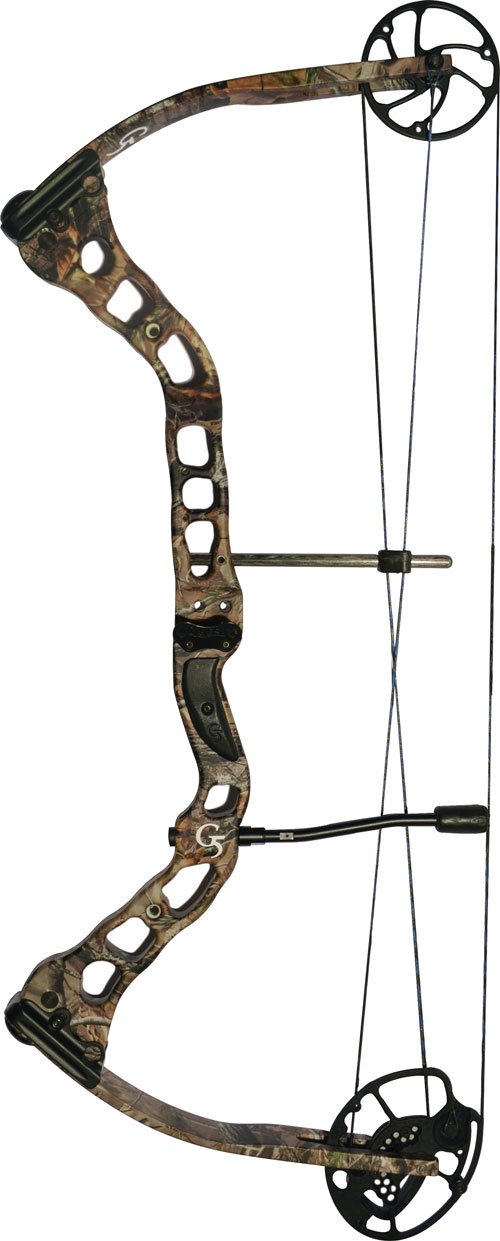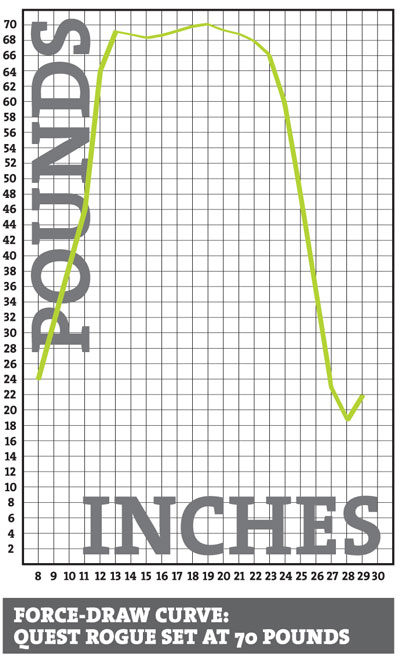From roots in precision manufacturing for the medical industry, little more than a decade ago G5 introduced the innovative Montec broadhead that remains a best-seller today. G5’s product line quickly grew to include additional broadheads and other archery accessories, as well as two lines of compound bows, one of which is Quest. In 2012 Quest introduced two new bows including the Rogue.
The high-end speed of 312 fps, while more than adequate, clearly signifies this bow is not intended to appeal to the bowhunter who puts the highest priority on raw speed. The Rogue is all about being smooth-drawing, pleasant-shooting, forgiving, and affordable.
 Virtually every feature of this bow’s design contributes to its shootability, beginning with the new Fluid Cam. Many shooters believe that single cams tend to be inherently smoother-drawing than is the case for other designs. The Fluid Cams feature a rotating module that allows for easy adjustment of draw length without a press by simply removing two screws, repositioning the module, and replacing the screws. A positive draw stop is then loosened and repositioned in accordance with a simple chart in the owner’s manual. Draw length is adjustable from 26 to 30.5 inches in half-inch increments. Among the more important features determining forgiveness is brace height, and the Rogue offers a generous 7.5 inches in that department. The aggressive parallel-limb design contributes to the lack of hand shock or recoil.
Virtually every feature of this bow’s design contributes to its shootability, beginning with the new Fluid Cam. Many shooters believe that single cams tend to be inherently smoother-drawing than is the case for other designs. The Fluid Cams feature a rotating module that allows for easy adjustment of draw length without a press by simply removing two screws, repositioning the module, and replacing the screws. A positive draw stop is then loosened and repositioned in accordance with a simple chart in the owner’s manual. Draw length is adjustable from 26 to 30.5 inches in half-inch increments. Among the more important features determining forgiveness is brace height, and the Rogue offers a generous 7.5 inches in that department. The aggressive parallel-limb design contributes to the lack of hand shock or recoil.
In addition to the Fluid Cams, the Rogue shares several features with Quest’s other 2012 offering, the somewhat faster (and somewhat more expensive) Torrent. These include a 6000 series forged aluminum riser, pivoting limb pockets, adjustable string stop, an injection-molded metal broadhead shelf, BCY 452x string, and a double-dipped Durafuse finish. The main differences, apart from the half-inch greater brace height for the Rogue and about 10 fps less speed, seems to be that the Torrent boasts Bowjax limb dampeners and Quest’s flexible I-Glide cable guard system, while the Rogue does not.
Grips are something bowhunters tend to be very picky about. The Quest bows feature textured plastic sideplates in a shape I find very comfortable. Quest describes them as “anti-slip” and states that they do not hold scent. I can’t speak to the no-scent issue, but I like the grip in part because I don’t find it anti-slip at all. (Personally, I want my grip to be slippery as a wet fish. I have never understood the desire for “sticky” grips or for shooting gloves designed to provide extra grip, which I believe can only magnify any inherent or shooter-induced torque. I want the grip to slide smoothly back into the same spot in my hand every time I draw the bow, and to that end wear a slick glove on my shooting hand.)
The Dura-fuse camo and the G5 and Quest logos contribute to an overall very high level of fit and finish, and inspecting the bow I found no visible flaws. While reflecting current technology, there is nothing radical about the Rogue’s design or appearance. That can be a good thing; I have in recent years encountered bows that could not be pressed with available presses, bows that would not fit into normal bow cases, and bows on which many popular rests or sights could not be properly installed or adjusted.
The M.I.M. broadhead shelf is a welcome safety feature, especially for shooters who like to minimize arrow weight with shorter arrows. And finally, many shooters will appreciate a straightforward, almost minimalist approach that includes no speed nocks on the string, no flexing or rolling parts on the cable guard, no special tools for making basic adjustments, and no unusual riser configuration to limit the style of rest, sight, or quiver used, or to make securing or adjusting those items difficult.
Shooting The Bow
All the G5 bows I’ve had occasion to shoot have been smooth-drawing; the Quest Rogue might be the smoothest drawing of all. Even the break-over from peak hold to the 80 percent letoff feels gradual—a welcome feature, since the rock-solid back wall could arrive with an arm-wrenching thump if the draw weren’t so ice cream-smooth. The feel of the bow is longer than its compact 31 inches. At the shot, it jumps forward slightly in a loose grip, with no torque that I could detect, and tips forward slowly in the hand. The Rogue is plenty quiet enough for hunting. There is a slight tuning fork sensation, but not noticeable enough to be unpleasant. A stabilizer reduced that, but it’s possible string silencers or limb dampeners might reduce it even more, as might tweaking the adjustable string stop. Tuning was simple enough; I used a level to square the arrow, eyeballed the centershot, and made a few adjustments to paper tune the bow, after which I was getting excellent arrow flight. To say this is a great bow for under $500 sounds like damning with faint praise; it might lack a few bells and whistles, but where it counts—in performance, forgiveness, and simple shooting enjoyment—it compares favorably with many higher-priced bows.
Quest Rogue Specs
Letoff:........................................ 80%
Brace Height.......................... 7 1/2 inches
Weight....................................... 4.2 pounds
Axle-To-Axle Length........... 31 inches
Speed.......................................... 312 fps (IBO)
Draw lengths......................... 26 to 30.5 inches
Draw weights........................ 50, 60, 70 pounds
Options...................................... Custom GFade Realtree AP finish
Suggested Retail.................. $430
Objective Tests (30 Inches Draw)
Peak Hold (Pounds)*............................ 70
Weight, Full Draw (Pounds)*........... 17
Arrow Weight........................................ 385 grains........ 500 grains
Arrow speed@ 70 Pounds*................ 297 fps............. 260 fps
Arrow speed @ 60 Pounds*............... 277 fps............. 239 fps
Sound Level (DBA).................................. 74..................... 68
*Rounded to nearest half-pound







